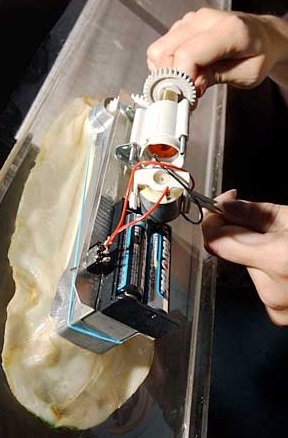Robot revolution digs on snails and clams for help
 Engineers have - as they often do - taken more cues from the designs nature developed millions of years ago.
Engineers have - as they often do - taken more cues from the designs nature developed millions of years ago.
This time, researchers in the US have developed a new squad of robots that dig and crawl about, mimicking the outstanding abilities of snails and clams.
Anette Hosoi, professor of mechanical engineering at the Massachusetts Institute of Technology, has been studying snails in the hope of learning their sticky tricks.
The team is most interested in the snail’s use of a sticky substance to attach itself to surfaces in gravity-defying ways, but which also reduces friction during movement.
It has led the University’s group to create ‘RoboSnail’, a new bot that can climb walls and stick to overhead surfaces much like its living counterpart.
The cyborg snail may find uses in anything from invasive surgery to oil-well drilling, among other applications.
The MIT team also pinched some of the techniques that allow clams to dig themselves down and become immovably wedged in the ground.
The engineers have also created ‘RoboClam’, hoping to better understand the organism’s behaviour and mechanics and explore the possibility of automated digging devices that use less energy than current approaches.
The researchers found that while digging, the clam’s up-and-down movement accompanied by opening and closing of its shell turns sand into the consistency of liquid quicksand. This in turn allows the clam to move quickly through the sand. Similar to Nature’s version; RoboClam vibrates, changing the solid seabed into fluid, allowing a worm-like foot to push itself downward.
Clam-inspired robotic diggers could find use as automatic tethers and lightweight low-cost anchoring devices for small submarines and even large ships and oil platforms.
Devices that burrow into the seabed could also potentially be used as detonators for underwater mines.
Engineers around the world have realised that brilliantly simple and efficient designs are all over the place, and they only need turn to insects, fish, birds and other animals for inspiration.
Professor Hanoi says it is important to not just copy the animals, but also to understand the biology of their mechanisms to see the key features that allow them to do what they do.
This kind of biomechanical study has led to a mutually-beneficial partnership between mathematicians and biologists in the research sphere.
Biologists can inform mathematical scientists as a goldmine of data is emerging as biology becomes more and more quantified. Mathematicians, in turn, can employ the tools of engineering and computation to analyse the data and offer new insights into the way animals move.
The following video features Prof Hanoi speaking on biologically-inspired designs.








 Print
Print